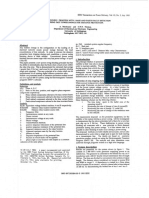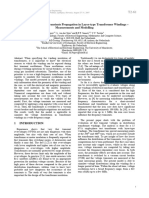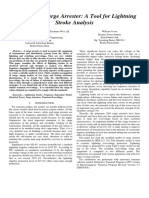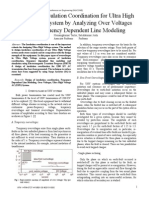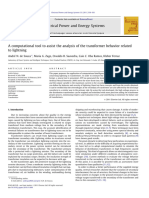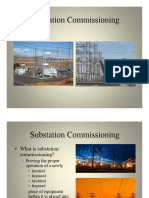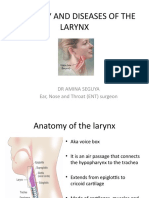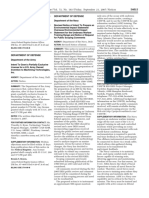Scheme For Accelerated Trip For Faults in The Seco
Scheme For Accelerated Trip For Faults in The Seco
Uploaded by
SALAH SALLAMCopyright:
Available Formats
Scheme For Accelerated Trip For Faults in The Seco
Scheme For Accelerated Trip For Faults in The Seco
Uploaded by
SALAH SALLAMOriginal Title
Copyright
Available Formats
Share this document
Did you find this document useful?
Is this content inappropriate?
Copyright:
Available Formats
Scheme For Accelerated Trip For Faults in The Seco
Scheme For Accelerated Trip For Faults in The Seco
Uploaded by
SALAH SALLAMCopyright:
Available Formats
See discussions, stats, and author profiles for this publication at: https://www.researchgate.
net/publication/3211836
Scheme for Accelerated Trip for Faults in the Second Zone of Protection of a
Transmission Line
Article in IEEE Power Engineering Review · May 1989
DOI: 10.1109/MPER.1989.4310591 · Source: IEEE Xplore
CITATIONS READS
4 109
5 authors, including:
Liu Pei O.P. Malik
Nanjing University of Science and Technology The University of Calgary
5 PUBLICATIONS 60 CITATIONS 682 PUBLICATIONS 15,642 CITATIONS
SEE PROFILE SEE PROFILE
All content following this page was uploaded by O.P. Malik on 18 August 2014.
The user has requested enhancement of the downloaded file.
tic is common in natural lightning and power line switching Instrumentation Performance
[3]. Likewise, the 10 ns x 1 50 ns wave was chosen because
it does result from certain power equipment switching and The instrumentation system worked very well. Data was
failure modes as well as from EMP conditions. obtained, stored and hard copies made, requiring minimal
operator effort and time. The problems encountered were
minor and most of them have been overcome by modification
Sensors to the equipment or software.
For the high voltage test program, copper sulfate dividers Conclusions
and wire wound resistance dividers were used for voltage
measurements. High frequency current transformers were This equipment is recommended by the author for measure-
chosen for current measurements, since they provided both ment of high and low voltage, steep fronted, short duration
the high frequency performance and circuit isolation that is impulse studies on apparatus and insulation systems.
preferable where simultaneous voltage and current measure-
ments are made.
For the low voltage impulse voltage distribution tests on References
power and distribution transformer windings, Tektronix 6102 [11 IEEE No. 4-1-978, Techniques for Dielectric Tests.
active probes were used. [21 International Electrotechnical Commission (IEC) Publica-
tion 60-2-1973, High-Voltage Test Techniques Part 2
Data Acquisition Equipment Test Procedures.
[31 "Steep Front Short Duration Low Voltage Impulse Per-
LeCroy 6880 and 8828 digitizers were procured for acquir- formance of Distribution Transformers", L. M. Burrage,
ing the data. A Compaq portable computer and LeCroy E. F. Veverka and B. W. McConnell, Transactions on
software provided the data display and storage, data reduc- Power Delivery, Vol. PRWD-2, No. 4, October 1987, pp.
tion, hard copy generation and digitizer control. 1152-1156.
Power System Relaying
88 SM 524-1 in succession, consider a typical transmission line with
April 1989 distance protection and circuit breakers at each end of the
line as shown in Fig. 1. For a fault at point P in the second
zone, the distance protection at line end L normally trips
Scheme for Accelerated Trip for Faults in the circuit breaker CL with time delay t2l. At the time the fault
Second Zone of Protection of a Transmission Line appears at P, the current through CL and the voltage at bus-
bar L change suddenly. This is the first change. Because of
Chen Deshu, Liu Pei, and Peng Hua the location of the fault, the circuit breaker CM trips first in a
Department of Electric Power Engineering time less than t2l. At this time the current through CL and the
Huazhong University of Science and Technology voltage at L change suddenly again. This second change can
People's Republic of China be used to trip breaker CL.
G. S. Hope and 0. P. Malik The current through CL depends upon the type of fault.
Department of Electrical Engineering Therefore, if the second change in the zero sequence current
The University of Calgary, Calgary, Alberta, Canada is used as the only criterion, the desired selectivity and
sensitivity of the protection is not satisfied. An analysis of the
problems and the countermeasures are described in the
Keywords: Transmission line protection; second zone faults; paper.
accelerated trip. Selectivity is improved by the use of the voltage at the end
of zone 1 as an auxiliary signal. Detailed analysis shows that
Summary this voltage is very effective in discriminating between a fault
on the line in the second zero and a fault outside the full-line.
To discriminate between faults near the end of the pro- A prototype impedance relay using the proposed accelera-
tected transmission line and at the beginning of the next line, tion function has been designed and built using a single-board
a time delay is used to coordinate tripping of impedance microcomputer. In the prototype device, a quadrilateral type
relays when the fault occurs in a zone spanning approxi- impedance unit with zero sequence current as the polarization
mately 20 percent line length near the end of the protected quantity is used for ground fault including two phase to
line. ground faults. A polyphase compensated impedance unit is
It would be advantageous if the distance protection could used for phase to phase faults and a mho unit with memorized
be made to operate without the time delay, when the fault voltage as polarization quantity is used for three phase faults.
occurs at any point on the protected line. Although the basic The prototype was first tested on a dynamic power system
characteristics of the impedance relays are such that they do model in the power systems laboratory at the Huazhong
not meet this requirement, they can be modified to accom- University of Science and Technology, PRC. The protected
plish fast full-line tripping under certain conditions. line consisted of four sections and the faults were applied at
A tripping scheme which gives fast full-line tripping for the junction of the third and fourth sections. A wide variety of
distance protection is described in this paper. In this scheme tests were performed with the prototype relay protecting the
the principle of operation, called "succession", is to acceler- transmission line. The main performance characteristics of
ate the second zone time delay of the distance protection the prototype are:
when the zero sequence current changes twice. The second
change occurs when the circuit breaker at the opposite end of i) it trips without any time delay when the fault occurs in
the faulted line trips. the first zone of distance protection.
To describe the basic principle of full-line trip immediately ii) the prototype gives full-line trip in succession after the
IEEE Power Engineering Review, April 1989 IEEE Power Engineering Review, April 1989 53
53
trip of the circuit breaker on the opposite end of the line if about 60% of the full value, growing to full value in about
fault occurs in the second zone and inside the protected three to four cycles. This is not explained by the classical
transmission line. ground resistance formulas. The authors believe that when a
iii) the device blocks accelerated triipping if the fault occurs conductor arcs to the surface of the ground, the arc will not
within the second zone but outsside the protected trans- stay terminated at exactly the surface. It will cause ionization
mission line. within the soil and so penetrate the ground, thus enlarging
iv) the acceleration function would Ifail in the rare situation the effective area of the equivalent electrode and generate a
of a fault in the second zone but inside the protected line nonlinear resistance effect. A second nonlinear effect occurs
if the fault progresses from a sinigle-phase to ground to a within the soil based on the silicon carbide (SIC) composition
double-phase to ground fault af ter 0.1 s and before the of most soils. Oscillograms show that this nonlinearity is not
circuit breaker at the opposite erid of the line has tripped. identical to that of the arc in air.
The figure shows that the harmonics generated by a live
The prototype device has operate rd on a 110 kV, 60 km conductor lying on the grouund were a minimum at about
long transmission line in the Hunan FProvince, PRC since July 90A fault current and actually increased at lesser fault
9, 1987. In the first five months of its operation, it gave a currents. This minimum harmonic point takes on additional
successful trip on the one fault in the nfirst zone of protection significance when it was observed that this test had the most
There were no faults in the second;zone and thus no results stable fault current. From this and other test data the authors
are available. Also, there were no fa ilse trips. conclude that a viable high impedance fault detector based on
Discusser: W. A. Elmore harmonic recognition is feasible. Conclusions are:
The nonlinearity in a high impedance fault has been
characterized in general terms and field data confirms the
L M reasonableness of the approach.
CL
I
r- [Z
I1
I
-.
- tn
y p
P
LCM I ,> The magnitudes of the resulting harmonic currents appear
sufficiently predictable to be utilized in a high impedance fault
detector.
Additional, controlled experiments are needed to accu-
rately quantify the parameters of a conductor/ground high
H1
--A-
L2 impedance interface.
Discussers: E. J. Emmerling, W. A. Elmore, M. Aucoin, C.
I-! Benner, D. Russell, D. R. Volzka, E. J. Rogers, and J. F. White
I I
Fig. 1. Principle of distance protection.
13 6
0
88 SM 529-0
April 1989 -4
Ground Resistance-Revisited 2 MAGNITUDE OF HARMONICS
Donald I. Jerrings, Member and John R. Linders, Fellow
Nordon R & D, Inc., Clearwater, Florida 2
--
I a I a
I
50 100 150 200
Abstract-The nature of ground resistance is examined to FAULT AMPUMRS
explain the high impedance of faults directly to ground as Fig. 1.
contrasted to conventionally assumed low impedance ground
faults to neutral conductor or to towers with low footing
resistance. High impedance faults are shown to be inherently
nonlinear due to the characteristics of soil. This nonlinearity is
shown to be different from that of the arcing between
conductor and ground. The harmonic content of the resulting 88 SM 526-6
current is judged to have characteristics which can be used to April 1989
distinguish such faults from normal load variations.
Keywords: ground faults, harmonics, high impedance, Summary of the "Guide for AC Generator
Protection" ANSI/IEEE C37.102-1987
Summary
A Working-Group Report for the Power System
The power industry's understanding of ground resistance Relaying Committee
was arrived at during the era of fundamental research when a L. E. Landoll, Chairman
low station ground impedance was found to enhance the
reliability and safety of power delivery and minimize cost of
equipment. The resulting station ground grid design parame- Abstract-This paper serves as an introduction to the Guide
ters used by the electric industry are based on simplification for AC Generator Protection (ANSI/IEEE C37.102-1987). It
of the basic equations of ground resistance. These result in a briefly describes the material contained in the guide and
ground interface resistance which is substantially linear with presents some examples. Those interested in the material
respect to fault current or system voltage magnitude. Using presented in the summary paper should obtain the complete
these simplified equations to explore the consequences of a document.
down conductor can lead to conclusions which are obviously Introduction
false.
Segments of oscillograms from recent tests are shown. A This new guide presents a review of the generally accepted
noticeable common features is that the initial current is only forms of protection for synchronous generator and their
54.54 Engineering Review,
IEEE Power Engineering Review, April
April 1989
View publication stats
You might also like
- Schematic - POCO X3 Pro - 2023 09 27Document4 pagesSchematic - POCO X3 Pro - 2023 09 27kashi kashi0% (1)
- Elgi EG SERIES MANUALDocument60 pagesElgi EG SERIES MANUALMulendra Singh Shishodia100% (2)
- Trilogy of Wireless Power: Basic principles, WPT Systems and ApplicationsFrom EverandTrilogy of Wireless Power: Basic principles, WPT Systems and ApplicationsNo ratings yet
- It Is Quite Another Electricity: Transmitting by One Wire and Without GroundingFrom EverandIt Is Quite Another Electricity: Transmitting by One Wire and Without GroundingRating: 4.5 out of 5 stars4.5/5 (2)
- Excavator: Cummins B5.9 Tier 2, Stage II 102 KW (137 HP) 22,000 KG 1.0 MDocument11 pagesExcavator: Cummins B5.9 Tier 2, Stage II 102 KW (137 HP) 22,000 KG 1.0 MKo ZayNo ratings yet
- Harris Quest FM 1kDocument72 pagesHarris Quest FM 1kIonuț Dragoș Gid100% (1)
- EeeDocument112 pagesEeeDilshad AhemadNo ratings yet
- IEEE Transactions: OccursDocument7 pagesIEEE Transactions: OccursFelix GamarraNo ratings yet
- Role of Controlled Switching On Transmission Line For SOV Mitigation-A ReviewDocument20 pagesRole of Controlled Switching On Transmission Line For SOV Mitigation-A ReviewDamian SNo ratings yet
- Analysis: Overvoltage Events Electric System To Switching LightningDocument7 pagesAnalysis: Overvoltage Events Electric System To Switching LightningBalajiNo ratings yet
- Study of 345 KV Transient Recovery Voltages On The Illinois Power SystemDocument6 pagesStudy of 345 KV Transient Recovery Voltages On The Illinois Power SystemJohn BihagNo ratings yet
- Short Circuit Analysis of Electrical DisDocument8 pagesShort Circuit Analysis of Electrical DisHeang sok leapNo ratings yet
- Arduino Based Underground Cable Fault DetectionDocument5 pagesArduino Based Underground Cable Fault DetectionBikila DesalegnNo ratings yet
- Arduino Based Underground Cable Fault de PDFDocument5 pagesArduino Based Underground Cable Fault de PDFRana AbrarNo ratings yet
- Investigation of Fast Transients PropagaDocument6 pagesInvestigation of Fast Transients PropagaM4gne7icNo ratings yet
- Underground Cable Fault Detection and Alert: Sujay S, R Monisha, Prathibha Rekha MurthyDocument6 pagesUnderground Cable Fault Detection and Alert: Sujay S, R Monisha, Prathibha Rekha MurthyShankar gowdaNo ratings yet
- Metal Oxide Surge Arrester A Tool For LiDocument6 pagesMetal Oxide Surge Arrester A Tool For LiCLAVOTNo ratings yet
- k1 FCL DigSilentDocument8 pagesk1 FCL DigSilentksg9731No ratings yet
- UntitledDocument6 pagesUntitledraghavendran raghuNo ratings yet
- Design HDocument7 pagesDesign HJohn Mark DalidaNo ratings yet
- Conductor Technologies in Transmission Networks Executive SummaryDocument3 pagesConductor Technologies in Transmission Networks Executive SummaryKunal RajaNo ratings yet
- Automatic Circuit Breaker ACB For Low Voltage SubsDocument23 pagesAutomatic Circuit Breaker ACB For Low Voltage Subsallan kiplimoNo ratings yet
- Performance of Quadrilateral Relay On EHV Transmission Line Protection During Various FaultsDocument6 pagesPerformance of Quadrilateral Relay On EHV Transmission Line Protection During Various FaultsMuhammad RamzanNo ratings yet
- Refference 2Document14 pagesRefference 2Anwar RazakNo ratings yet
- A Novel Methodology For Power Transformer Differential Protection by Incorporating Artificial Neural NetworkDocument7 pagesA Novel Methodology For Power Transformer Differential Protection by Incorporating Artificial Neural Networknimishbhatt1607No ratings yet
- Various Algorithms To Detect Faults On Underground Cables Based On Impedance MethodDocument6 pagesVarious Algorithms To Detect Faults On Underground Cables Based On Impedance MethodRahat Ali KhanNo ratings yet
- Various Algorithms To Detect Faults On Underground Cables Based On Impedance MethodDocument6 pagesVarious Algorithms To Detect Faults On Underground Cables Based On Impedance MethodRahat Ali KhanNo ratings yet
- Various Algorithms To Detect Faults On Underground Cables Based On Impedance MethodDocument6 pagesVarious Algorithms To Detect Faults On Underground Cables Based On Impedance MethodRahat Ali KhanNo ratings yet
- TMP 2 C17Document18 pagesTMP 2 C17FrontiersNo ratings yet
- Base Paper - 4Document11 pagesBase Paper - 4Bazila AyoubNo ratings yet
- Distance Calculation For Underground Cable Fault: ISSN (ONLINE) : 2250-0758, ISSN (PRINT) : 2394-6962Document5 pagesDistance Calculation For Underground Cable Fault: ISSN (ONLINE) : 2250-0758, ISSN (PRINT) : 2394-6962Alexis AguillonNo ratings yet
- Optimizing The Operation of Current Differential Protection by Power Differential Relay For Three Phase TransformerDocument6 pagesOptimizing The Operation of Current Differential Protection by Power Differential Relay For Three Phase TransformerNohelia CruzNo ratings yet
- Short Circuit Currents To Perform A Protective Device Coordination StudyDocument7 pagesShort Circuit Currents To Perform A Protective Device Coordination StudyshofiasksNo ratings yet
- Power System ProtectionDocument4 pagesPower System ProtectionInternational Journal of Innovative Science and Research TechnologyNo ratings yet
- Effective Placement of Surge Arrester During Lightning: G. Radhika, Dr.M.Suryakalavathi and G.SoujanyaDocument6 pagesEffective Placement of Surge Arrester During Lightning: G. Radhika, Dr.M.Suryakalavathi and G.SoujanyamanmanNo ratings yet
- Transients RestrikesDocument9 pagesTransients RestrikesjgerandNo ratings yet
- 0 ShortCircuitCurrentCharacteristicsAnalysisandImprovedCurrentLimitingStrategyforDocument16 pages0 ShortCircuitCurrentCharacteristicsAnalysisandImprovedCurrentLimitingStrategyforamina bu bakerNo ratings yet
- Relay Coordination 1 PDFDocument5 pagesRelay Coordination 1 PDFNikhil SainiNo ratings yet
- Investigations Into The Transformer Inrush Current Problem: E-Mail Addresses: Barry - Rawn@brunel - Ac.ukDocument7 pagesInvestigations Into The Transformer Inrush Current Problem: E-Mail Addresses: Barry - Rawn@brunel - Ac.ukmassimo bartoliNo ratings yet
- An Intelligent Overcurrent Relay To Protect Transmission Lines Based On Artificial Neural NetworkDocument10 pagesAn Intelligent Overcurrent Relay To Protect Transmission Lines Based On Artificial Neural NetworkInternational Journal of Power Electronics and Drive SystemsNo ratings yet
- The Analysis of Lightning Overvoltage by Emtp For Lightning Protection Design of 500 KV Substation Noor Azila Binti Khazaimah TK3091.N66 2006Document4 pagesThe Analysis of Lightning Overvoltage by Emtp For Lightning Protection Design of 500 KV Substation Noor Azila Binti Khazaimah TK3091.N66 2006Badr Eddine BendrissNo ratings yet
- Analysis and Review - Secondary Arc Extinction Auto Reclosing For 765 KV EHV TLDocument3 pagesAnalysis and Review - Secondary Arc Extinction Auto Reclosing For 765 KV EHV TLCarlos Lino Rojas AgüeroNo ratings yet
- Fault Location in Power Transformers During Impulse TestsDocument6 pagesFault Location in Power Transformers During Impulse TestsMozar CostaNo ratings yet
- R02 - 32SI - Insulation System For Refrigerant PipingDocument4 pagesR02 - 32SI - Insulation System For Refrigerant PipingRatilal M JadavNo ratings yet
- Schneider Short Circuit CalculationDocument36 pagesSchneider Short Circuit Calculationincobar100% (3)
- Savic 1989Document8 pagesSavic 1989dankorankoNo ratings yet
- On The Analysis of Lightning Surges Arriving To Cable Terminated Transformer UsingDocument4 pagesOn The Analysis of Lightning Surges Arriving To Cable Terminated Transformer UsingGermanilloZetaNo ratings yet
- Solid-State Circuit Breakers and Current Limiters For Medium-Voltage Systems Having Distributed Power SystemsDocument8 pagesSolid-State Circuit Breakers and Current Limiters For Medium-Voltage Systems Having Distributed Power Systemsrazila rasheedNo ratings yet
- Crossley 2005BDocument9 pagesCrossley 2005BJames FitzGeraldNo ratings yet
- A Novel Online Technique To Detect Power Transformer Winding FaultsDocument9 pagesA Novel Online Technique To Detect Power Transformer Winding FaultsV S B Chaitanya DuvvuryNo ratings yet
- PNM Approach To Protecting Overcompensated High-Voltage LinesDocument13 pagesPNM Approach To Protecting Overcompensated High-Voltage LinesDiego Fernandez ErazoNo ratings yet
- Relay Protection of Highvoltage Electrical Power System.Document147 pagesRelay Protection of Highvoltage Electrical Power System.Tongle GooNo ratings yet
- Ieee Schavenmaker 2000aDocument5 pagesIeee Schavenmaker 2000avallala venkateshNo ratings yet
- A Computational Tool To Assist The Analysis of The Transformer Behavior Related To Lightning - 2011 - DesouzaDocument6 pagesA Computational Tool To Assist The Analysis of The Transformer Behavior Related To Lightning - 2011 - DesouzaquadriakinwandeNo ratings yet
- Communications 3: Transmission Media and Antenna Systems and DesignDocument117 pagesCommunications 3: Transmission Media and Antenna Systems and DesignJohn Wilfredd CurimoNo ratings yet
- Short Circuit Analysis of 33/11/0.4 KV Distribution System Using ETAPDocument8 pagesShort Circuit Analysis of 33/11/0.4 KV Distribution System Using ETAPEmre MetinNo ratings yet
- Lab - 01Document7 pagesLab - 01Shahid ButtNo ratings yet
- A Survey On Recent Low Voltage Ride-Through Solutions of Large Scale Wind FarmDocument5 pagesA Survey On Recent Low Voltage Ride-Through Solutions of Large Scale Wind FarmthefacelessgangsterNo ratings yet
- Health Index Monitoring Assessment of A TransformerDocument6 pagesHealth Index Monitoring Assessment of A TransformerOmkar WaghNo ratings yet
- Protective Relays Navigation SearchDocument5 pagesProtective Relays Navigation Searchsolo66No ratings yet
- Differential Relay Reliability Impliment Enhancement of Power TransformerDocument7 pagesDifferential Relay Reliability Impliment Enhancement of Power TransformerAde SafitriNo ratings yet
- Project 1Document7 pagesProject 1Sanjay YadavNo ratings yet
- Short Circuit Current Algorithm and Software DesigDocument9 pagesShort Circuit Current Algorithm and Software Desigpran14nykNo ratings yet
- Introduction to Power System ProtectionFrom EverandIntroduction to Power System ProtectionRating: 5 out of 5 stars5/5 (1)
- Protective Relay Analysis AbbDocument3 pagesProtective Relay Analysis AbbSALAH SALLAMNo ratings yet
- (3) الوقاية والأمان د.عبد العزيزDocument37 pages(3) الوقاية والأمان د.عبد العزيزSALAH SALLAMNo ratings yet
- Testing and Commissioning of Electrical InstallationsDocument36 pagesTesting and Commissioning of Electrical InstallationsSALAH SALLAMNo ratings yet
- Substation CommissioningDocument34 pagesSubstation CommissioningSALAH SALLAMNo ratings yet
- FMACS 1 - 5 Treble ClefDocument13 pagesFMACS 1 - 5 Treble ClefTristan ScottNo ratings yet
- Goal Setting Guide: Create Your Most Amazing Year Yet!Document8 pagesGoal Setting Guide: Create Your Most Amazing Year Yet!AnteNo ratings yet
- FE-Seminar 10 15 2012Document38 pagesFE-Seminar 10 15 2012yerytNo ratings yet
- Aero Technology Dgca Easa Module 15 Part 6 EngineDocument32 pagesAero Technology Dgca Easa Module 15 Part 6 EnginemarshallNo ratings yet
- T96 Acoustic Transducer Is. 2 Mar 13Document2 pagesT96 Acoustic Transducer Is. 2 Mar 13Watchara ThepjanNo ratings yet
- Anatomy and Diseases of The LarynxDocument19 pagesAnatomy and Diseases of The LarynxANENA RHODANo ratings yet
- Disassemble and Assemble Computer Hardware: 1. Click The Rufus AppDocument5 pagesDisassemble and Assemble Computer Hardware: 1. Click The Rufus AppPaulo CelisNo ratings yet
- Supercritical Turbine TrainingDocument7 pagesSupercritical Turbine TrainingEngr Imtiaz Hussain GilaniNo ratings yet
- Boycheva CVDocument2 pagesBoycheva CVMirena BoychevaNo ratings yet
- Worksheet Cash Flow-Direct Method RevDocument15 pagesWorksheet Cash Flow-Direct Method RevJason Waldron TjahjonoNo ratings yet
- Android On A Non-Mobile Embedded SystemDocument24 pagesAndroid On A Non-Mobile Embedded SystemAnonymous xeu1KQNo ratings yet
- Configure SAML SSO For SAP Cloud Platform Using An External Identity Provider - SAP Blogs PDFDocument18 pagesConfigure SAML SSO For SAP Cloud Platform Using An External Identity Provider - SAP Blogs PDFvikas_anne_1No ratings yet
- Strategic Marketing ZamtelDocument9 pagesStrategic Marketing ZamtelClive NyowanaNo ratings yet
- Government of Assam: Ref No.: DITEC - No.160/2021/131 Release Date: 28 June 2022Document66 pagesGovernment of Assam: Ref No.: DITEC - No.160/2021/131 Release Date: 28 June 2022ANUJ RAWATNo ratings yet
- Flower BusinessDocument5 pagesFlower BusinesssujeethNo ratings yet
- Making Prototypes: by Andrew GilliattDocument5 pagesMaking Prototypes: by Andrew GilliattFractalzNo ratings yet
- Assessment of Learning BLEPT NOTESDocument16 pagesAssessment of Learning BLEPT NOTESGabriel JavierNo ratings yet
- Irene O. Atseyinku, A058 536 724 (BIA Jan. 21, 2015)Document15 pagesIrene O. Atseyinku, A058 536 724 (BIA Jan. 21, 2015)Immigrant & Refugee Appellate Center, LLC100% (1)
- How To Restore A Backup of The Romexis Database?: 3D Diagnostics in Dental OfficeDocument6 pagesHow To Restore A Backup of The Romexis Database?: 3D Diagnostics in Dental OfficeElSuperbeastoNo ratings yet
- Bar Ans Er EEDocument10 pagesBar Ans Er EEODYLOU CAMILLE MONTOJONo ratings yet
- Stepper MotorDocument59 pagesStepper Motorya zool / يا زولNo ratings yet
- PGH Session Tunebook PrintDocument204 pagesPGH Session Tunebook PrintXavier BettecherNo ratings yet
- Tip of The Costberg - On The Invalidity of All Cost of Regulation Estimates and The Need To Compile Them AnywayDocument164 pagesTip of The Costberg - On The Invalidity of All Cost of Regulation Estimates and The Need To Compile Them AnywayClyde Wayne Crews Jr.No ratings yet
- Notice: Environmental Statements Availability, Etc.: Base Closures and Realignments— Semi-Permanent Backup Iron SightDocument1 pageNotice: Environmental Statements Availability, Etc.: Base Closures and Realignments— Semi-Permanent Backup Iron SightJustia.comNo ratings yet
- AI and Future Prospects of Privacy: - Vedant Choudhary Symbiosis International (Deemed) UniversityDocument10 pagesAI and Future Prospects of Privacy: - Vedant Choudhary Symbiosis International (Deemed) Universityeeshaan singhNo ratings yet







